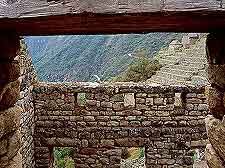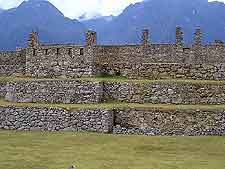Machu Picchu History Facts and Timeline
(Machu Picchu, Peru)

Today, Machu Picchu is considered to be the main jewel in Peru's tourism crown, but this ancient Inca city remained undiscovered until nearly four centuries in history, after it was abandoned following the Spanish conquest.
Ancient Inca watch towers and check points are still scattered across the long valleys leading to Machu Picchu's iconic dry-stone walls, deep within the Andes Mountains. Recent daily entrance restrictions and a 2010 flood which forced a three-month closure of the entire site have done little to slow the steady flow of tourists to this 'old peak.'
Ancient Inca City
The exact year that the history of Machu Picchu began remains rather unknown. However, experts widely believe that its construction occurred in the middle of the 15th century, when it was built as an estate for Pachacuti, an Inca emperor whose reign lasted from 1438 to 1472. As many as 750 people called this spot their home during its peak as an elite country resort and city. The Temple of the Three Windows, the Temple of the Sun and the Intihuatana shrine are amongst the main buildings still standing today.
Inca Abandonment
Despite this ancient site's now iconic status, its original prestige was relatively short-lived. Just over a century after its original construction, Machu Picchu was suddenly abandoned many years after the Spanish conquest.
Although there is no evidence that the Spanish ever set eyes on these ruins, many believe that smallpox killed off most of Machu Picchu's original residents. The site's sacred rocks, unlike those in several other sacred Inca landmarks, remained untouched by Spanish conquistadors. Machu Picchu would stay abandoned, forgotten and undiscovered for several centuries to come.

Hiram Bingham Discovery
The next chapter in the history of Machu Picchu would not be written until 1911, when a young local boy led Hiram Bingham to this isolated and long abandoned location. Bingham, an American archaeologist, was actually searching for the historic Inca site of Vilcabamba, as part of his Yale University sponsored excursion.
Although a handful of other explorers were rumoured to have seen Machu Picchu during the previous 50 years, Bingham was the first to collect artefacts and write books about the complex he chose to name the 'Lost City of the Incas'. An entire National Geographic issue was dedicated to this ancient site in the spring of 1913. Bingham brought many of his artefacts to the United States and after several centuries of controversy, Yale University finally returned some of these to Peru in 2007.
Restoration and Tourism
Machu Picchu's three main buildings may have been remarkably well-preserved by the time Bingham discovered them, but most of the smaller surrounding buildings are actually reconstructions. About 30 percent of Machu Picchu was restored to its original splendour in 1976, and this percentage has only grown larger in subsequent years.
By the turn of the new millennium, over 400,000 tourists visited Machu Picchu per year, many of whom hiked along the famous Inca Trail, built by the Incas so many centuries ago. The site's status as Peru's most popular tourist attraction, however, was not achieved without some growing pains.
Aircraft and helicopters cannot fly over Machu Picchu and, since 2011, only 2,500 visitors may enter the complex per day. These restrictions were imposed to preserve the splendour and history of this archaeological landmark for generations to come.
 Today, Machu Picchu is considered to be the main jewel in Peru's tourism crown, but this ancient Inca city remained undiscovered until nearly four centuries in history, after it was abandoned following the Spanish conquest.
Today, Machu Picchu is considered to be the main jewel in Peru's tourism crown, but this ancient Inca city remained undiscovered until nearly four centuries in history, after it was abandoned following the Spanish conquest.